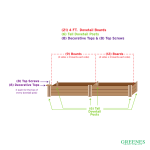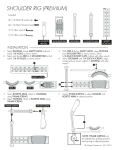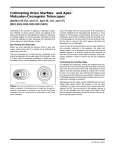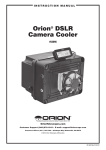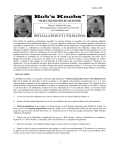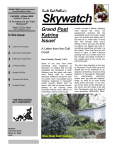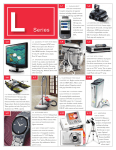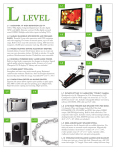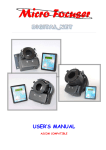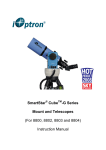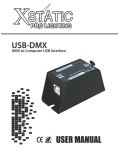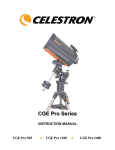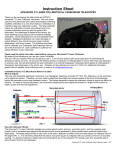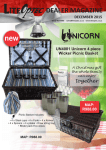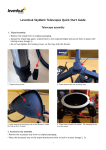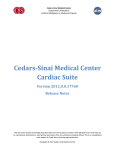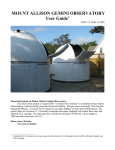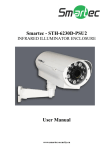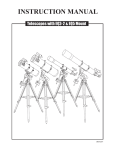Download DSV-2 User Manual - Desert Sky Astro Products
Transcript
DSV-2 ALTITUDE-AZIMUTH TELESCOPE MOUNT User Manual Your New Mount Thanks for choosing the Desert Sky Astro Products DSV-2 mount. Take some time to familiarize yourself with its features (Figure 1). Please read the user manual completely before using mount. 12 11 10 9 20 18 19 13 17 5 6 16 8 15 7 14 4 3 2 1 Figure 1: Parts of the DSV-2 mount DESERT SKY ASTRO PRODUCTS Phoenix, AZ, USA DSV-2 User Manual Rev - 1) Mounting socket (underside of base plate) 2) Base plate 3) Azimuth bearing housing & built-in column 4) Azimuth slow motion knob 5) Altitude slow motion knob 6) Altitude bearing housing 7) Panning handle 8) Right side dovetail clamp 9) Right side dovetail clamp knob 10) Altitude brake Page 1 11) Bubble level 12) Left side dovetail clamp knob 13) Left side dovetail clamp 14) Left side dovetail clamp set screws (3) 15) QBS adjustment plate 16) QBS balancing weight 17) QBS balancing track 18) QBS adjustment plate slots (2) 19) QBS adjustment knobs (2) 20) QBS short dovetail adapter Package contents The shipping box contains a fully assembled DSV-2 mount, a fully assembled Quick Balance System (QBS) unit, Velcro dot balance point markers, a Velcro strip and wrenches. Other items may be present in the box depending on your specific order. Please remove protective wrapping prior to use. mount, telescopes and accessories used and equipped with mounting bolt that matches the mount. Leveling the Mount Use the built-in bubble level to level the mount. While perfect leveling is not required, an out of level mount will not perform well. Attaching the QBS The QBS attaches to the left or right side dovetail clamp by sliding the short dovetail adapter into the corresponding dovetail clamp, as shown in Figure 2. To facilitate installation, place the balancing weight so that it is aligned with the altitude axis. Tighten dovetail knob to secure QBS in place. Recommended Payload The DSV-2 mount is recommended for use with Refractor telescopes up to 102mm f/7, SchmidtCassegrain telescope (SCT) up to 8” aperture and Maksutov-Cassegrain telescope (MCT) up to 6” aperture. Attaching mount to a tripod The mount attaches to a tripod (sold separately) by threading the tripod’s mounting screw onto the mount mounting socket. Recommended tripods are Desert Sky Astro Products Surveyor-Style Tripod or any heavy duty tripod capable of supporting the combined weight of the DSV-2 User Manual Rev - Figure 2: Attaching the QBS Page 2 The QBS is shipped configured for mounting to the right side dovetail clamp. If left side installation is desired, reverse the balancing track so the QBS is configured as shown in Figure 3. Figure 3: QBS in left side clamp configuration Attaching a telescope and setting up QBS QBS must be setup prior to operating the mount. Proper balancing of the altitude axis is essential for the correct operation of the DSV-2 mount. Prepare the telescope to be used with the mount by installing the star diagonal, finder, tube rings and the lightest eyepiece you will regularly use. The telescope must be equipped with a Vixen-style dovetail bar adapter in order to be attached to the DSV-2 mount. Prepare the QBS by applying the supplied Velcro strip to the top edge of the balancing track. DSV-2 User Manual Rev - 1. Adjust the QBS so that the balancing track is all the way up on the rear adjustment slot and approximately in the middle of the front adjustment slot, and the balancing weight is all the way to the back end of the track. The balancing track is adjusted by loosening the two knurled QBS knobs and sliding the track on the adjustment slots, then tightening the adjustment knobs. The balancing weight is adjusted by turning it counterclockwise to loosen, sliding it to the desired position and turn weight clockwise to set in place. Insert the telescope and slide the telescope back or forth on the dovetail clamp (or the telescope on the tube rings) to balance the telescope in the front/back direction as shown in Figure 4. Tighten dovetail clamp knob once telescope is balanced. Small EP Velcro strip Slide telescope back or forth to balance, tighten dovetail clamp knob after balancing. Balancing weight all the way back and balancing track all the way up on adjustment slot. Figure 4: QBS setup step 1 Page 3 2. Point telescope at or near the zenith and check if telescope is balanced for high pointing angles (telescope should not tip forward or back). Adjust the position of the balancing track on the rear adjustment slot as needed to obtain balance. This may be necessary if your smallest EP is not so small and/or you are using a finder scope. See Figure 5. Small EP not tend to drift in any direction. Mark the rear end of the balancing track with one of the supplied Velcro dots 3. Engage the altitude brake. Remove the small EP and insert the largest EP you intend to regularly use with your telescope and the DSV-2 mount. Typically, up to a 35mm Super Wide Angle or 26mm Ultra Wide Angle can be balanced with a 102mm f/7 refractor (41mm SWA/31mm UWA with an 80mm F/7 refractor), although this will depend on the particular telescope being used. For extra heavy EPs or binoviewers an extra weight may be required. Call or email for more details. Release the altitude brake while holding the telescope to prevent sudden tipping. Slide the balancing weight forward on the track until the telescope is balanced in the back/front direction, as shown in Figure 6. Large EP Slide rear end of balancing track on the rear adjustment slot to balance scope at high pointing angles Figure 5: QBS setup step 2. When the telescope is properly balanced, it takes the same amount of force to swing it up or down and it will Slide balancing weight forward until scope is balanced in the front/back direction. Figure 6: QBS setup step 3 DSV-2 User Manual Rev - Page 4 Mark the balancing point with one of the supplied Velcro dots. 4. Point telescope at or near the zenith and check if telescope is balanced for high pointing angles (telescope should not tip forward or back). Adjust the position of the balancing track on the front adjustment slot as needed to obtain balance, as shown in Figure 7. not tend to drift in any direction. Tighten the QBS adjusting knobs to set the balancing track in place. Once the balancing points for the smallest and largest EPs in your set have been identified, the balancing points for the remaining EPs can be found by installing the EP and adjusting the balancing weight on the track until the telescope is balanced. Mark each balancing point with one of the Velcro dots supplied (5 total). Changing Eyepieces To change EPs during an observing session, engage the altitude brake, remove the current EP, the install the new EP and move the balancing weight to the balancing point corresponding to the new EP. Then release the altitude brake to continue observing. Large EP Slide balancing track on the front adjustment slot to balance scope at high pointing angles Figure 7: QBS setup step 4 When the telescope is properly balanced, it takes the same amount of force to swing it up or down and it will DSV-2 User Manual Rev - Removing the telescope If you remove the telescope for storage at the end of the observing session, put an indexing mark (small piece of tape or crayon mark) on the telescope’s dovetail bar to record its position with respect to the dovetail clamp. This way you will not need to setup the QBS again when the telescope is reinstalled on the mount. Removing the QBS The QBS can be removed for mount transportation or storage. Put an indexing mark (small piece of tape or crayon mark) on the QBS dovetail adapter to record its position with respect to the dovetail clamp. This way you Page 5 will not need to setup the QBS again when it is reinstalled on the mount. Slow Motion Controls The DSV-2 is equipped with geared slow motion controls. Slip clutches allow the slow motion controls to move the mount without the need to unlock/lock the axes for slewing. A small amount of friction is used to transfer the slow motion control inputs to the mount (hence the importance of properly balancing the mount). Turning the altitude slow motion knob clockwise will move the telescope towards the zenith and counterclockwise will move the telescope move the telescope towards the horizon. the DSV-2 mount makes it ideal for scanning the sky with a short focal length telescope. The handle can be removed by unthreading it from the dovetail clamp. Double Telescope Operation The DSV-1 can be used with two telescopes in a side by side configuration. To use in double telescope mode, at least one of the scopes must be equipped with tube rings. In this mode, the QBS (with the short dovetail adapter removed) in attached to the top holes of the tube rings of one of the scopes, as shown in Figure 8. It is preferable to attach the QBS to the lighter of the two telescopes being used, for better Azimuth axis balance. Follow the steps listed in the “setting up QBS” section to setup QBS for double telescope use. Turning the azimuth slow motion clockwise will move the telescope to the right (clockwise as seen from the top) and counterclockwise moves the telescope to the left. The slow motion controls are adjusted at the time the mount is assembled. No adjustments are needed during normal use. If you believe the slow motion controls in your mount need adjustment, please email for further instructions. Panning Handle A panning handle is provided standard with the DSV-2 mount. It can be used for slewing the mount and pointing the telescope. The panning handle and lock-less design of DSV-2 User Manual Rev - Figure 8: Setup for double telescope operation Page 6 Aligning the two dovetail clamps For double telescope operation, you may want to align the two dovetail clamps so the two scopes point at the same object. Because the alignment between the optical tube and dovetail bar varies from telescope to telescope, alignment of the dovetail clamps must be made with the actual telescopes to be used. Alignment is more easily done during the day. Find a distant, easily visible object (i.e. a power transmission tower). WARNING: NEVER POINT TELESCOPES AT OR NEAR THE SUN. DAMAGE TO THE EYES AND/OR THE INSTRUMENT MAY OCCUR. Perform the following steps: 1. Remove the QBS if it is attached to the mount. 2. Mount a telescope (with star diagonal, EPs, etc attached) on the dovetail clamp on which you intend to use the telescope (for example, if you intend to use a refractor on the left side and a Maksutov on the right side, they should be mounted to that side during alignment). 3. Roughly balance the scopes by sliding back or forth on the dovetail clamps as needed, tighten the dovetail clamp knobs. 4. Point the mount to the object chosen and center it in the field of view of the right side telescope. 5. Engage the altitude brake tightly. 6. Loosen slightly the left side dovetail clamp setscrew (located on the underside of the clamp). DSV-2 User Manual Rev - 7. Rotate up or down the left side telescope on the altitude axis as needed so the object is centered in up/down direction in the field of view of the left hand telescope (object may not be centered in the left/right direction, this will be corrected in the following steps). 8. Tighten the left side dovetail clamp setscrew. 9. Release the altitude brake. 10.Center (up/down and left/right) the alignment object in the field of view of the left side telescope. Object should be centered in the up/down direction in the field of view of the right side telescope. If not, repeat steps 4-8. 11. Engage the altitude brake. 12. On the right side dovetail clamp, loosen the front setscrew (located next to the panning handle) and back setscrew (located opposite the panning handle). 13. Tighten the front or back dovetail clamp setscrew as needed to center the object in the left/right direction of the right side telescope. Which setscrew to tighten will depend on the type of telescope and type of diagonal (star or correct image) used. 14. Once the object is centered in both directions in the field of view of both scopes, tighten the setscrews. 15. Reinstall QBS as needed for single telescope or double telescope operation. Page 7 Alignment Notes: a. If you notice after aligning the dovetail clamps that the friction in the altitude axis has increased or decreased compared to the original setting, it can be adjusted by tightening or loosening either side dovetail clamp cap screw (located on the center of the face of the dovetail clamp, scopes must be removed to perform this adjustment). Only a small adjustment is needed, work in small increments until the original setting is restored. The amount of friction in the altitude axis must be equal to that in the azimuth axis and just enough for the slow motion controls to operate. If in doubt, email us for further instructions. b. The right side dovetail setscrews offer a limited adjustment range. Prior to attempting to align the dovetail clamps, make sure the dovetail bar is aligned with the optical tube. If the misalignment between the dovetail bar and optical tube is too large, alignment of the views may not be possible. Mount Care Store mount protected from the elements. If the mount becomes wet or soiled during use, wipe water or dirt with clean lint-free cloth and allow it to dry indoors. All bearings and moving parts have been lubricated at manufacture and do not require further lubrication during use. The mount is not intended to be disassembled or serviced by user. Please call or email if mount needs service. Warranty and Service Your mount is guaranteed to be free of material and workmanship defects for one year from date of original purchase. Within this period of time, Desert Sky Astro Products will repair or replace at its discretion any defective components. This is the only and exclusive warranty offered. Abuse, accidental damage and unauthorized modifications & repairs are not covered by the warranty. To obtain service, please call 602-550-4331 or email [email protected] to make return arrangements. ©2011 Desert Sky Astro Products. c. The alignment of the dovetail clamps is specific for the scopes used during the alignment process. If you later switch to different scopes, the views may not be aligned (due to differences in the alignment between the telescope’s optical tube and dovetail bar). Repeat alignment process for the new telescopes, if desired. DSV-2 User Manual Rev - Page 8








